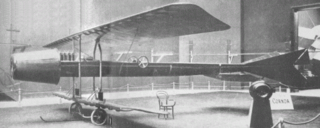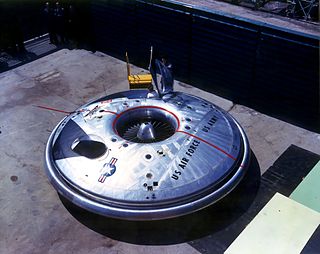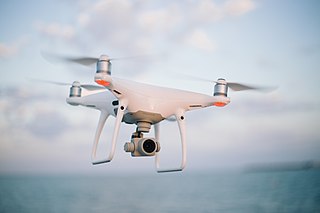A vertical take-off and landing (VTOL) aircraft is one that can hover, take off and land vertically without relying on a runway. This classification can include a variety of types of aircraft including helicopters as well as thrust-vectoring fixed-wing aircraft and other hybrid aircraft with powered rotors such as cyclogyros/cyclocopters and gyrodynes.

An aircraft engine, often referred to as an aero engine, is the power component of an aircraft propulsion system. Most aircraft engines are either piston engines or gas turbines, although a few have been rocket powered and in recent years many small UAVs have used electric motors.

Henri Marie Coandă was a Romanian inventor, aerodynamics pioneer, and builder of an experimental aircraft, the Coandă-1910 described by Coandă in the mid-1950s as the world's first jet, a controversial claim disputed by some and supported by others. He invented a great number of devices, designed a "flying saucer" and discovered the Coandă effect of fluid dynamics.

The Coandă effect is the tendency of a fluid jet to stay attached to a convex surface. It is named after Romanian inventor Henri Coandă, who described it as "the tendency of a jet of fluid emerging from an orifice to follow an adjacent flat or curved surface and to entrain fluid from the surroundings so that a region of lower pressure develops."

The Coandă-1910, designed by Romanian inventor Henri Coandă, was an unconventional sesquiplane aircraft powered by a ducted fan. Called the "turbo-propulseur" by Coandă, its experimental engine consisted of a conventional piston engine driving a multi-bladed centrifugal blower which exhausted into a duct. The unusual aircraft attracted attention at the Second International Aeronautical Exhibition in Paris in October 1910, being the only exhibit without a propeller, but the aircraft was not displayed afterwards and it fell from public awareness. Coandă used a similar turbo-propulseur to drive a snow sledge, but he did not develop it further for aircraft.

The Rolls-Royce Pegasus, formerly the Bristol Siddeley Pegasus, is a British turbofan engine originally designed by Bristol Siddeley. It was manufactured by Rolls-Royce plc. The engine is not only able to power a jet aircraft forward, but also to direct thrust downwards via swivelling nozzles. Lightly loaded aircraft equipped with this engine can manoeuvre like a helicopter. In particular, they can perform vertical takeoffs and landings. In US service, the engine is designated F402.
A circular wing is a disc-shaped wing having the outer planform of a circle.

A tail-sitter, or tailsitter, is a type of VTOL aircraft that takes off and lands on its tail, then tilts horizontally for forward flight.

An airplane or aeroplane is a fixed-wing aircraft that is propelled forward by thrust from a jet engine, propeller, or rocket engine. Airplanes come in a variety of sizes, shapes, and wing configurations. The broad spectrum of uses for airplanes includes recreation, transportation of goods and people, military, and research. Worldwide, commercial aviation transports more than four billion passengers annually on airliners and transports more than 200 billion tonne-kilometers of cargo annually, which is less than 1% of the world's cargo movement. Most airplanes are flown by a pilot on board the aircraft, but some are designed to be remotely or computer-controlled such as drones.

The Avro Canada VZ-9 Avrocar was a VTOL aircraft developed by Avro Canada as part of a secret U.S. military project carried out in the early years of the Cold War. The Avrocar intended to exploit the Coandă effect to provide lift and thrust from a single "turborotor" blowing exhaust out of the rim of the disk-shaped aircraft. In the air, it would have resembled a flying saucer.

A miniature UAV, small UAV (SUAV), or drone is an unmanned aerial vehicle small enough to be man-portable. Smallest UAVs are called micro air vehicle.

An Entomopter is an aircraft that flies using the wing-flapping aerodynamics of an insect. The word is derived from entomo + pteron. Entomopters are type of ornithopter, which is the broader term for any device intended to fly by flapping wings.

A quadcopter or quadrotor is a type of helicopter with four rotors.

A rotorcraft or rotary-wing aircraft is a heavier-than-air aircraft with rotary wings or rotor blades, which generate lift by rotating around a vertical mast. Several rotor blades mounted on a single mast are referred to as a rotor. The International Civil Aviation Organization (ICAO) defines a rotorcraft as "supported in flight by the reactions of the air on one or more rotors".

John Carver Meadows Frost was a British aircraft designer. His primary contributions centred on pioneering supersonic British experimental aircraft and as the chief designer who shepherded Canada's first jet fighter project, the Avro Canada CF-100, to completion. He was also the major force behind the Avro Canada VTOL aircraft projects, particularly as the unheralded creator of the Avro Canada flying saucer projects.

A helicopter is a type of rotorcraft in which lift and thrust are supplied by horizontally spinning rotors. This allows the helicopter to take off and land vertically, to hover, and to fly forward, backward and laterally. These attributes allow helicopters to be used in congested or isolated areas where fixed-wing aircraft and many forms of STOL or STOVL aircraft cannot perform without runway.

A flying saucer is a descriptive term for a type of flying craft having a disc or saucer-shaped body, commonly used generically to refer to an anomalous flying object. The term was coined in 1947 but has generally been supplanted since 1952 by the United States Air Force term unidentified flying objects. Early reported sightings of unknown "flying saucers" usually described them as silver or metallic, sometimes reported as covered with navigation lights or surrounded with a glowing light, hovering or moving rapidly, either alone or in tight formations with other similar craft, and exhibiting high maneuverability.
Ghatak is an autonomous stealthy unmanned combat air vehicle (UCAV), being developed by Aeronautical Development Establishment (ADE) of Defence Research and Development Organisation (DRDO) for the Indian Air Force. The design work on the UCAV is to be carried out by Aeronautical Development Agency (ADA). Autonomous Unmanned Research Aircraft (AURA) was a tentative name for the UCAV. Details of the project are classified.

The Demon is an experimental unmanned aerial vehicle (UAV) developed and manufactured by British defence conglomerate BAE Systems. It has been referred to as being the world's first "flapless" aircraft.

The Xplorair is a project of compact VTOL aircraft without rotating airfoil from aerospace engineer Michel Aguilar, funded by the French Armed Forces procurement agency DGA and supported by various European aeronautics firms such as Dassault Systèmes, EADS Innovation Works, MBDA, Altran Technologies, Sogeti, Turbomeca, COMAT Aerospace and the Institut Pprime. Announced in 2007, the project aimed to develop a UAV prototype scheduled for flight in 2017, followed by a single-seater flying car whose commercialization could occur the decade after.
















